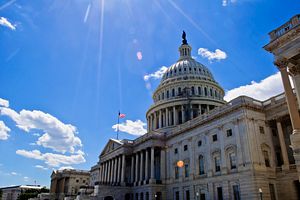Headlines surrounding the ongoing negotiations on a trade deal between the United States and China generally focus on the efforts of lead negotiators from both sides, including U.S. Treasury Secretary Steven Mnuchin, U.S. Trade Representative Robert Lighthizer, and Chinese Vice Premier Liu He.
Under-reported, however, is the participation of other official groups on the American side, which are also lending their weight of office to the efforts to resolve the trade issues between the world’s two largest economies.
Last week, the Ripon Society and the Franklin Center for Global Policy Exchange* hosted the co-chair of the U.S.-China Working Group (USCWG) at a breakfast meeting in Washington, D.C. to brief guests on their March trip to China.
Tellingly for the tone of the current U.S. – China relationship, USCWG’s trip was the first congressional delegation to go to China in the last eight months. The U.S.-China Working Group is made up of Republican and Democratic congressional members whose mission “seeks to build diplomatic relations with China and educate Members of Congress through meetings and briefings with business, academic and political leaders from the U.S. and China.”
The most surprising takeaway from this briefing was a statement by Democrat Rick Larsen, one of the co-chairs: “We wanted to be there to support the [Trump] administration’s message while we were over there.”
In fact, the trip and its meetings with the Chinese were a coordinated effort between the Trump administration’s negotiating team and the bipartisan congressional delegation. Prior to leaving, Darin LaHood (the Republican co-chair of USCWG) and Larsen “met with Ambassador Lightizer.” Upon their return, they “debriefed him yesterday before Lightizer left for Beijing”.
This is the story that most people aren’t hearing. As Larsen said,
In Congress there are national security hawks on China, trade hawks on China, and human rights hawks on China. So long as they didn’t talk to each other, they didn’t realize they all hated China…In the last few years those three groups have found each other and have created a different consensus in Congress, and on where that center of gravity sits.
Stating that although “it’s fair to say that some of us differ with the administration in their approach,” Larsen said that in China, he left that message “at home.”
Larsen and then Congressman Mark Kirk, a Republican from Illinois, created the USCWG in 2005 to, as Larsen said, “try to find a place in Congress where we could talk rationally about the U.S.-China relationship.”
Both LaHood and Larsen represent districts in their home states that are heavily impacted by China trade.
Caterpillar has its largest footprint in America in LaHood’s district, which sits in central and west central Illinois and is home to other heavy manufacturing interests. Caterpillar, according to the congressman, has 29 plants in China, and four R&D centers.
His district is also the eighth largest agricultural district in the United States, and sends 25 percent of its substantial corn and soybean crop to China. Illinois exports more soybeans to China than any other U.S. state.
But, LaHood added, these exports are important “parochially to my district,” underscoring the fact that while his district is feeling pain from agricultural exports, which are down 13 percent overall, he recognizes that his role is to support a deal that is fair to America across the board.
Larsen’s district, meanwhile, is home to a major Boeing facility; Boeing is America’s “single largest exporter, and China is a critical market for the company” (The aircraft company also has a presence in LaHood’s Illinois). Stating that the U.S.-China relationship is “in a trough,” Larsen said that 60 percent of the jobs in his county rely on trade. Quoting two studies, Larsen said that an all-out trade war would hit his county harder than any other in the United States.
Nonetheless, both men stressed that the goals of the trade talks, and any resolution to them that comes about, must include “substantive, structural change” on the part of the Chinese and how they deal with the United States.
LaHood, stating that “what we don’t want is a purchase agreement; we could have had a purchase agreement six months ago, if that’s what we had wanted,” said that the real goal of the talks that are underway is “how we get China to abide by the same rules as the rest of the industrialized world.”
Larsen, supporting LaHood’s perspective, added that the enforcement mechanism in any deal would be key.
“What do we put in place that causes them to comply?” he added.
Larsen related that Li Zhanshu, chairman of China’s National People’s Congress, told the six-member delegation that “enforcement is two ways.” If you enforce something on us, Li essentially said, “then we want to enforce something on you, too.”
As if those cryptic remarks weren’t enough, LaHood related that the CEO of Wanxiang Group, a Chinese multinational in the auto parts industry, told them, “The problems in trade aren’t between Beijing and Washington, they’re between Democrats, Republicans, and Communists.”
“There’s a narrow path here,” for an agreement with the Chinese, LaHood said.
Agreement between Democrats and Republicans has never looked so robust, however. Perhaps the trade war needs to go on a little longer for that reason alone.
*A previous version of this article misidentified the Franklin Center for Global Policy Exchange as the Franklin Center for Government and Public Integrity.

































